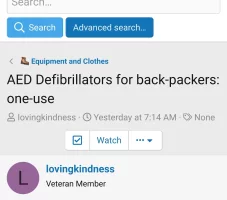Twenty years ago, I took a wilderness medicine course to prepare for an extended period of long-distance offshore sailing. I asked the instructor about the utility of carrying a defib device on the boat. He did not recommend it because he said defib is the first step in field emergency care and it needed to be followed immediately (within an hour or so) by transport to a hospital setting where advanced care can be rendered. He indicated that without immediate follow-up by trained medical professionals, defib alone probably would not improve the survival of a victim of cardiac arrest. As follow-up care would not be available on an offshore sailing boat, I decided not to buy a defib unit.
The Camino is not as remote as offshore sailing and there are many situations where access to immediate advanced care might be possible (e.g., towns and villages within short distances of hospitals); but alas, much of the Camino is remote enough that it would probably take more than the “golden hour” for emergency services to arrive on scene and transport a victim to hospital.
No doubt care protocols and survival rates have improved in the last 20 years, but the abstract of a somewhat dated 2005 medical paper published in the Mayo Clinic Proceedings seems to back up the advice I received that immediate follow-up in a hospital setting is a critical factor.
“…Survival after VF out-of-hospital cardiac arrest (OHCA) depends on a sequence of events called the chain of survival, which includes rapid access to emergency medical services, cardiopulmonary resuscitation, defibrillation, and advanced care.”
A query to ChatGPT4o (which is not necessarily a completely reliable source) yielded a 2015 study published by JAMA that suggests that survival outcomes provided by basic life support (defined below) can be as effective as advanced life support out-of-hospital care.
Here’s a quote from the article that seems to indicate that defib units need to be supplemented by additional life support interventions, e.g. CPR:
“Advanced life support (ALS) providers, or paramedics, are trained to use sophisticated, invasive interventions to treat cardiac arrest, including endotracheal intubation, intravenous fluid and drug delivery, and semiautomatic defibrillation. In contrast, basic life support (BLS) providers, or emergency medical technicians, use simple devices such as bag valve masks and automated external defibrillators…
“However, ALS has no established benefit over BLS for patients with cardiac arrest. Of the few high-quality comparisons that exist, the most robust is a before-after study from Ontario, Canada, which found that ALS did not improve survival to hospital discharge compared with a BLS system that optimized the time to defibrillation. Research from the United States is scant, but observational studies from urban areas of other high-income countries have also failed to find a benefit of prehospital ALS. Similarly, studies on the effectiveness of airway management favor BLS, and evidence of the benefits of intravenous drug delivery in the prehospital setting is limited.”
I claim no medical expertise, but it seems to me that in the Camino setting, defib devices alone may not reduce the number of memorials we see along the trail (many presumably resulting from cardiac issues). Carrying a portable defib unit may help, but only if accompanied by training in CPR and basic life support and, equally critical, immediate access to medical support / transport.
Access to immediate medical support implies knowing where you are geographically at all times (available from the GPS in your adequately-charged smart phone) and how to access emergency services (in Spain dial 112).
Links to papers referenced above:















